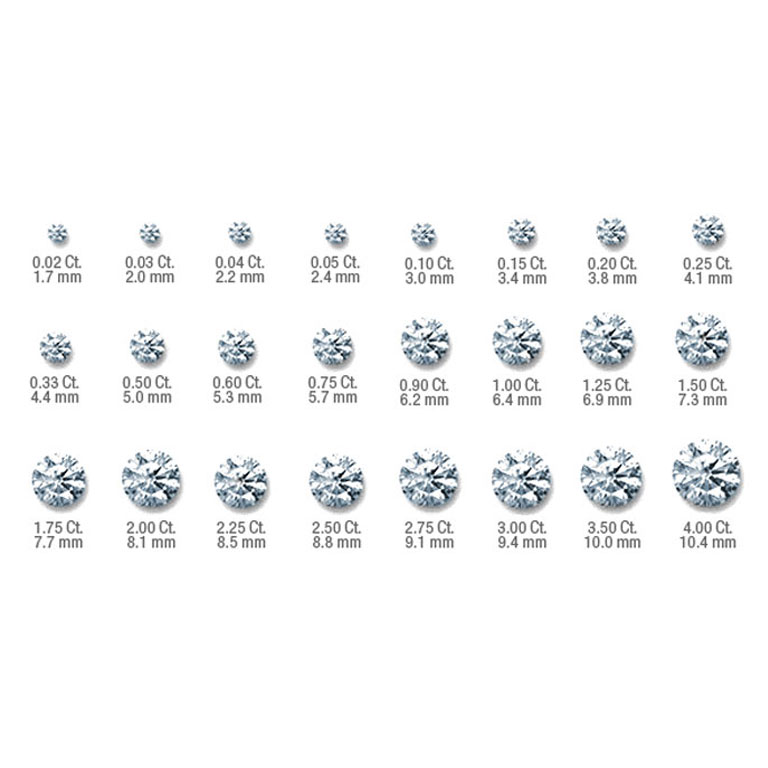4'CS OF DIAMONDS
The Universal language of know how Diamonds


To simplify the subject of diamond grading, the 4Cs relate to cut, color, clarity and carat weight - a universal language that was established with the Gemological Institute of America (GIA) and The combination of these factors determines a diamond`s relative rarity and value.

CUT
- An expertly cut diamond with perfectly symmetrical and aligned facets will maximise sparkle. This is because it reflects light internally from one mirror-like facet to another, dispersing it through its uppermost surface, referred to as the table. Finally, the polish gives a diamond its beautiful outside finish.
- The color, clarity and size of diamonds are predetermined by Nature. Only the cut depends on the talent and expertise of a diamond-cutter. For the very same reason, the cut of a diamond is a crucial quality factor in the four C’s grading system. Exemplary cutting of a rough diamond can turn the gemstone into an exceptional masterpiece.
- Technical expertise and artistry are required to create perfect angles and proportions. Graded by the GIA on a scale from Excellent to Poor, the cut is what fully unlocks a diamond’s potential. A badly cut diamond can appear dull and it is therefore possible for a well cut diamond to command a higher value than one that is slightly larger or of a rarer color.

COLOR
- White diamonds occur in a variety of shades, from truly colorless, which is very rare, to warm whites with hints of yellow. After which they become Fancy colors. The difference between one shade and the next is very subtle, so grading in the laboratory is performed under controlled lighting, placing the polished diamond upside down and using master samples for comparison and accuracy.
- Diamonds are graded on a scale of 23 shades, from ice white D (colorless) to warmer Z (light color). At R. A. Diamond, we look at the color grade of a white diamond as an indication of its rarity rather than a statement of its quality or suitability. We carry the full range in order to give clients more choice. A warm white color might suit you better than one that is icy white, and because its price is lower, you then have the exciting option of buying a diamond that is much larger than you ever thought possible.
- The face up color of the diamond, after grading in the laboratory, can, however, be quite different, possibly much brighter if the sparkle of the diamond is very high, which explains why beauty can be found in every shade of color.

CLARITY
- Natural diamonds have been created by extreme heat and pressure deep within the earth, millions, and even billions, of years ago. This organic process means that just about all diamonds contain internal features, for example traces of minerals or uncrystallised carbon, called inclusions. Clarity refers to a diamond’s natural inclusions.
- Even when invisible to the naked eye, inclusions and blemishes can still influence the way light is reflected and refracted, which is why their shape, size and position is taken into account in diamond grading reports. Diamonds with fewer of these characteristics are deemed to have a higher clarity, ranging from the very rare FL (flawless internally and externally) to I, signalling a number of more significant inclusions and blemishes. As the 4Cs all influence each other to some extent, characteristics of diamond clarity can be balanced by those of color when you are choosing your diamond.
- FL, IF:Flawless, Internally Flawless. There are no inclusions — internal flaws — or blemishes — external flaws. VVS1, VVS2: Very, Very Slight Inclusions. Hard to view such inclusions under 10x magnification. An excellent quality diamond. SI1, SI2: Slight Inclusions. Inclusions are visible under 10x magnification and may not be visible to the naked eye when the stone is in the face-up position. I1, I2, I3: Included: Inclusions are obvious under 10x magnification and may affect transparency and brilliance. I1 diamonds have inclusions that are almost always visible to the naked eye.

CARAT
- Carat is a measurement of weight, with one diamond carat equal to 200 milligrams. The term is derived from the word ‘carob’ because in the ancient world, carob seeds were used as a reference for diamond weight. Precise measurements are taken to the hundredth decimal place to ensure complete accuracy.
- Carat by itself does not affect a diamond’s value. As large diamonds are more rare and desirable, they are more valuable, but two diamonds of equal carat weight may have different values based on the other factors. At R. A. Diamond, we always cut for maximum beauty, not for weight, so you can be sure that your diamond will be the most beautiful in the world.
- One carat is the equivalent of 0.2 grams One carat is also divided into 100 points. Points are generally used to describe increments of weight within a carat. The weight of a 3/4-carat diamond can be shown as .75 carats or 75 points.
- Gold Land Building, 2nd Floor, Suite No. 217, Gold Souq, Deira, Dubai - U.A.E.
- Tel : +971-4-2561-334
- Fax: +971-4-2561-338
- Email: sales@radiamond.in
Copyright © 2024 | R. A. Diamond
Designed By Diamond King Software
Designed By Diamond King Software
